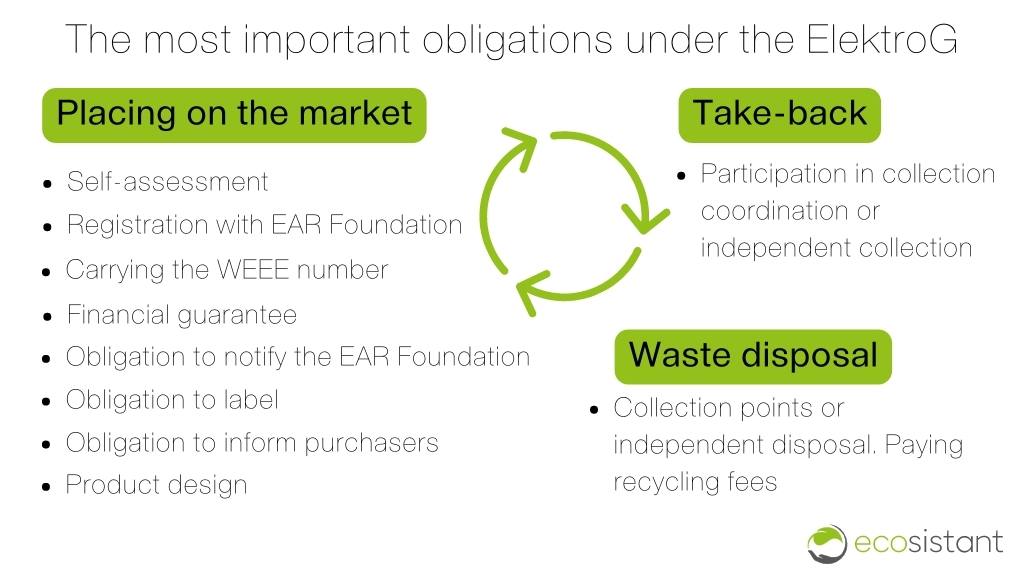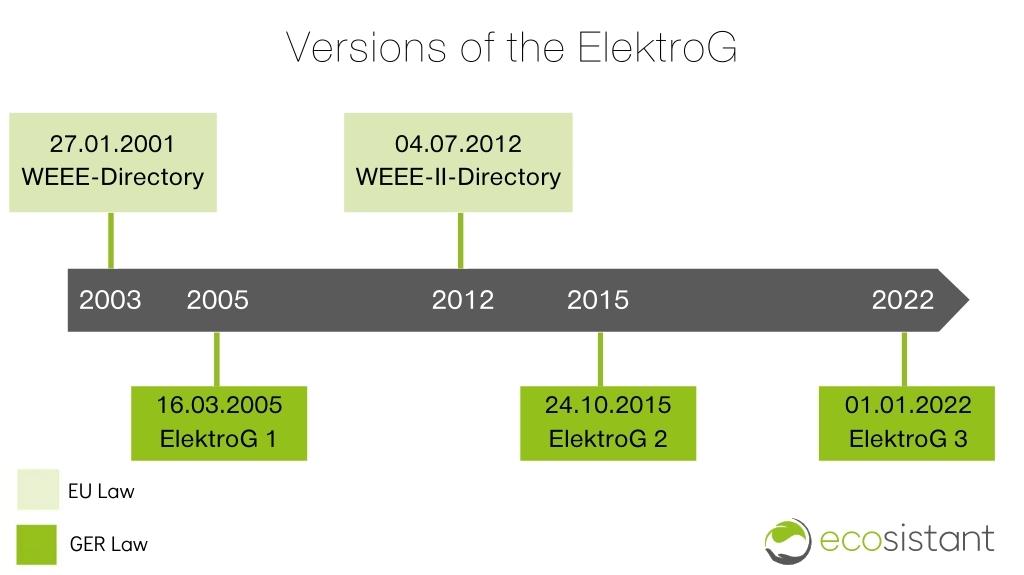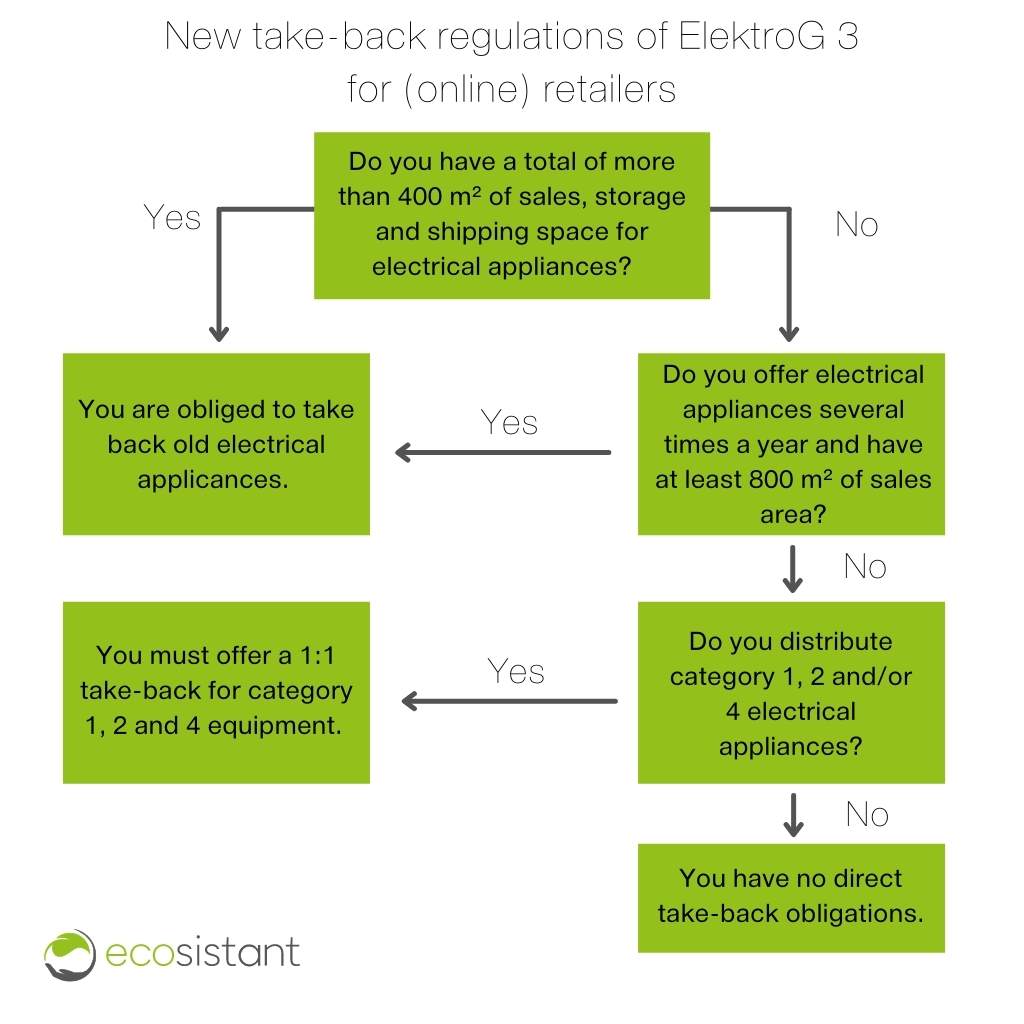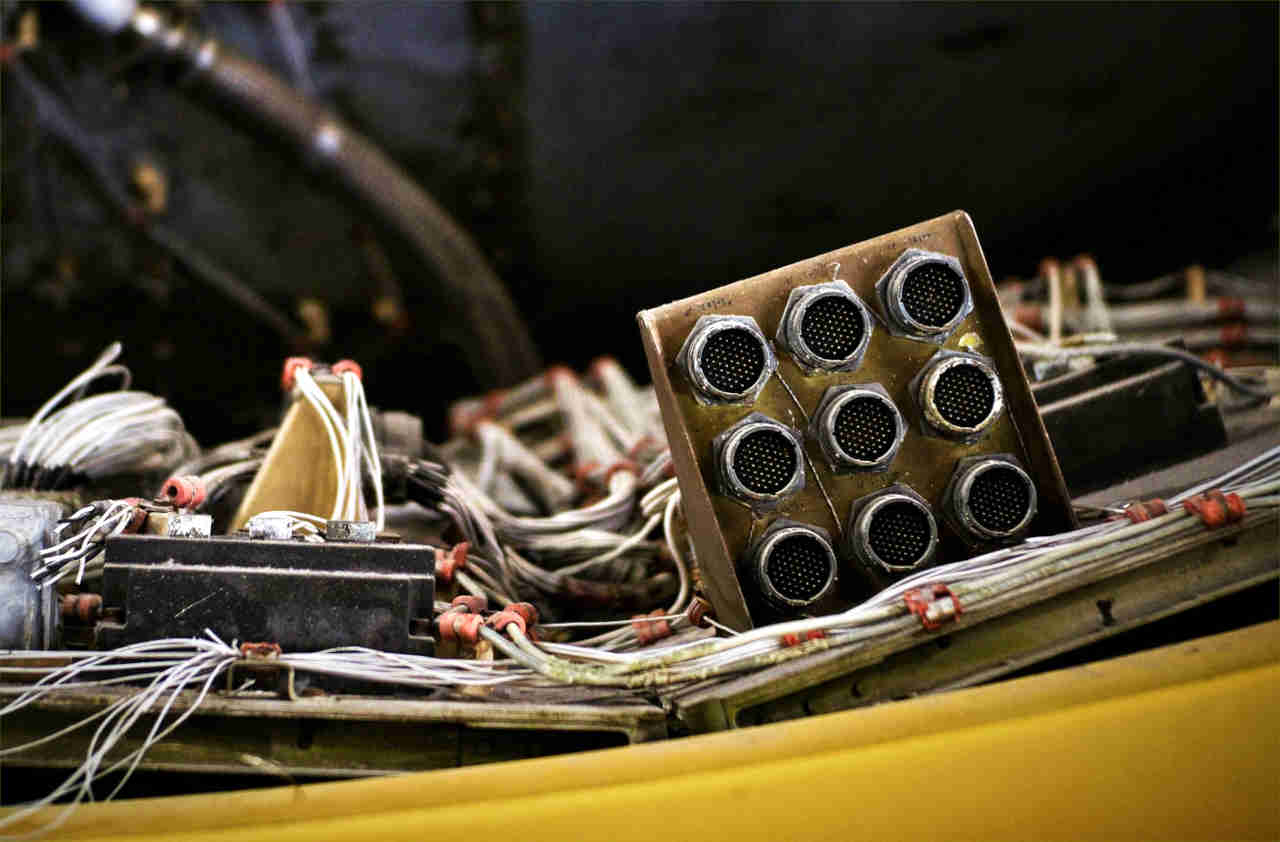The German Electrical and Electronic Equipment Act (ElektroG) sets out requirements that all parties involved in the sale of electrical devices in Germany must adhere to. The third version came into force on 1 January 2022.
In this article, we give you an overview of the Electrical and Electronic Equipment Act, its amendment and what this specifically means for online retailers who sell products in Germany.
What is the Electrical and Electronic Equipment Act (ElektroG)?
The Electrical and Electronic Equipment Act is the German implementation of the European Directive on Waste Electrical and Electronic Equipment.
The so-called WEEE Directive (Waste Electrical and Electronic Equipment Directive) has been in force in Europe since 2003.
It aims to make European trade with electrical equipment more environmentally friendly by transferring obligations to ensure the recycling of their electrical products to the responsible companies.
The aim of this extended producer responsibility is to prevent the release of toxic substances from old electrical equipment into the environment and to curb the waste of reusable materials associated with improper disposal.
Who is affected by the ElektroG?
The ElektroG applies to manufacturers and distributors as well as importers and drop shippers. Online retailers are also included. However, the obligations for the individual parties differ slightly.
Which appliances are covered by the ElektroG?
The ElektroG covers all appliances that require electric current or an electromagnetic field to operate or that generate, transmit or measure such currents or fields. Among others, this includes refrigerators, televisions, LED lamps and mobile phones.
Specifically, according to the Electrical and Electronic Equipment Act, this means all electrical equipment that generates an alternating voltage of no more than 1,000 volts or a direct voltage of no more than 1,500 volts when in operation. No distinction is made between commercial (B2B) and household appliances (B2C).
In the following table you will find an overview of the six appliance categories according to § 2 section 1 of the Electrical and Electronic Equipment Act with example appliances.
| Category | Equipment | Specification | Examples |
| 1 | Heat exchangers | - | Refrigerators, air conditioners |
| 2 | Screens, monitors and equipment containing screens | Contains surface area greater than 100 square centimetres | Televisions, laptops, tablets |
| 3 | Lamps | - | Fluorescent lamps, LED lamps |
| 4 | Large appliances | At least one of the external dimensions is more than 50 centimetres | Washing machines, dishwashers, light fittings, photocopiers |
| 5 | Small appliances | None of the external dimensions exceeds 50 centimetres | Vacuum cleaners, lamps, microwave ovens, toasters, irons, video cameras |
| 6 | Small information and telecommunication technology appliances | None of the external dimensions exceed 50 centimetres | Mobile phones, pocket calculators, telephones, USB cables |
However, certain appliances are considered exceptions and are not affected by the Electrical and Electronic Equipment Act.
These include, among others, individual appliance parts that belong to another electrical appliance and can only be used in that appliance. This is because only finished end devices that can be used independently by the end user are relevant for the ElektroG.
Further exemptions are light bulbs, stationary large industrial tools and large installations as well as mobile machinery and more.
The overview of all exemptions can be found in § 2 section 2. Annex 1 of the Electrical and Electronic Equipment Act also contains a list with further examples of the six product categories affected by the Electrical and Electronic Equipment Act.
What exactly does the ElektroG regulate?
The Electrical and Electronic Equipment Act (ElektroG) regulates which obligations companies must fulfil when they place electrical and electronic equipment on the market, which take-back obligations they have and how the environmentally friendly disposal of this equipment is to be ensured.
In fact, the full name of the Electrical and Electronic Equipment Act is “Act Governing the Sale, Return and Environmentally Sound Disposal of Electrical and Electronic Equipment”.
In the following, we provide a brief overview of the respective obligations in these three sub-areas.

Placing on the market
According to the Electrical and Electronic Equipment Act, “placing on the market” refers to making electrical and electronic equipment available on the market for the first time. This also applies to the reintroduction of products that were temporarily withdrawn from the market.
Before electrical and electronic products may be offered for sale, a number of obligations must be fulfilled. In addition, there will be further recurring obligations once the products are being sold.
Self-assessment
Classification of one’s own products into equipment categories and derivation of one’s own concrete obligations.
Registration with the EAR foundation
Registration of the electrical equipment with the Clearing House (Gemeinsame Stelle): the EAR Foundation.
Carrying the WEEE number
Indication of the WEEE registration number when offering products and on invoices as well as in other relevant places (website imprint, e-mail signature, etc.).
Financial guarantee
Annual provision of an insolvency-proof financial guarantee as security for the take-back and disposal of the electrical and electronic equipment in the event of a market exit.
Notification obligations towards the EAR foundation
Monthly (B2C) / annual (B2B) reports on sales volumes, reports on disposal, etc.
Labelling obligation
Printing of the manufacturer’s identification (brand) and the symbol of the crossed-out wheeled bin (with bar) on the electrical appliances.
Information obligations towards buyers
Written information to be provided to customers at the time of purchase. E.g. on correct disposal and the crossed-out wheeled bin, general take-back obligations and own take-back offers.
Product design
Consideration of the reusability and recyclability of electrical appliances in the design.
Take-back obligation
Participation in the collection coordination of the EAR Foundation (especially B2C) or independent take-back of the sold electrical appliances.
Disposal
Cooperation with public waste management authorities (ÖrE), which manage municipal collection points (e.g. recycling centres), or disposal of own old appliances. Payment of recycling fees.
What are the penalties for violating the ElektroG?
Anyone who violates the ElektroG must expect penalties such as warnings, court proceedings, operating bans, profit skimming and fines of up to 100,000 euros. The exact amount of the penalty or fine depends on the type of violation.
For example, a violation of the monthly reporting obligations of the quantity of electrical appliances or a missed/late collection of a collection container for the old appliances can be fined 10,000 euros.
Failure to register with the EAR Foundation or late registration, incorrect labelling of equipment and failure to comply with the take-back obligation can even result in fines of 100,000 euros each.
But disregarding recycling obligations to the detriment of environmental protection and raw material recovery is not the only reason for fines. Those who do not comply with the Electrical and Electronic Equipment Act also run the risk of being warned due to a violation of competition law.
This is because other companies can also claim damages from you if you have a competitive advantage (e.g. lower costs) due to the omitted obligations. As a consequence, you may be threatened with a profit skimming, i.e. you would have to pay certain amounts in arrears.
Unfortunately, there are many pitfalls regarding compliance with the Electrical and Electronic Equipment Act. In our digital consulting service you will receive free, detailed guidance on how to safely comply with all obligations under the ElektroG in Germany.
The amendment of the ElektroG
As mentioned, the Electrical and Electronic Equipment Act is the implementation of the European WEEE Directive into German law. The WEEE Directive was originally adopted in 2001, which was followed by the first version of the Electrical and Electronic Equipment Act in 2005.
Since then, the ElektroG has been amended twice. The latest version of the Electrical and Electronic Equipment Act (ElektroG 3), which came into force in 2022, differs in that it was not amended in the course of a previous update of the WEEE Directive.
This time, the Electrical and Electronic Equipment Act was amended to further improve the processes in Germany in order to be able to implement the WEEE Directive even more effectively, especially with regard to points in which there were still implementation difficulties.

What changes to the ElektroG will apply from 1 January 2022?
Version 3 of the Electrical and Electronic Equipment Act (ElektroG 3) has brought some changes. Several points apply to B2B manufacturers. These include, among others, the extension of the notification obligations to B2B manufacturers. Furthermore, a new take-back concept applies to them. From now on, B2B manufacturers have to present a concept for the take-back and recovery of their old appliances to the EAR Foundation.
Another important change is the tightening of the law regarding the removability of batteries. It should be possible to remove batteries from all electrical appliances placed on the market in Germany for the first time after 1 January 2022 without any problems or destruction. Or at least this should be easily possible for qualified personnel.
Furthermore, the Electrical and Electronic Equipment Act will also apply to operators of online marketplaces and fulfilment service providers from 2022. They will be given the obligation to regularly check the electrical and electronic equipment offered on their platform for the existence of a proper registration in terms of the Electrical and Electronic Equipment Act. Non-registered devices can no longer be offered.
In addition, from now on all collection and take-back points must be marked with the corresponding collection point logo of the EAR Foundation:

These changes to the ElektroG are now important for online retailers who sell in Germany
Some of the changes also specifically affect online retailers who sell in Germany. In the following we explain the most important points.

New calculation of the square metre threshold from which the general take-back of appliances is obligatory
Until now, only retailers with a sales area of at least 400 m2 for electrical appliances were obliged to take back any WEEE free of charge. From now on, the relevant area is no longer limited to the salesroom. Instead, all sales, storage and shipping areas are to be included. This means that online retailers may also be affected. If the total area amounts to more than 400 m2, you become liable to take back any old appliances.
In addition, new regulations regarding the square metre threshold came into force, which mainly affect grocery shops. These must now also take back old appliances if they have a total sales area of at least 800 m2 and offer electrical appliances several times a year.
Extension of the take-back obligations for individual categories of equipment
From January 2022, online retailers with a sales area of less than 800 m2 must also offer a so-called 1:1 take-back service free of charge for some of the appliance categories. This means that customers must be actively offered the take-back of a similar appliance when they purchase a new electrical appliance.
Affected are appliances of categories 1 (heat transmitters), 2 (screens, monitors and appliances with a surface area of more than 100 cm2) and 4 (large appliances).
This measure is intended to create a greater incentive for consumers to actually return these appliances or to give them directly to the transport service provider upon delivery of the new appliance. Until now, customers had to pay the shipping costs themselves.
The appliances of categories 3, 5 and 6 can still be taken back via suitable return points, etc.
New Obligations to Provide Information on the take-back of Electrical and Electronic Equipment
Since the take-back figures for electrical appliances in Germany have not increased for a while, from 2022 onwards retailers will be obliged to offer their customers the possibility of taking them back more clearly. The aim is to ensure that more people actually make use of this offer and that recycling rates increase as a result.
In online shops, the option of 1:1 take-back when buying a new appliance can be implemented as follows:
1) By linking to an information page on the take-back options.
2) The “request” whether an old appliance should be taken back can be made via a checkbox during the purchase process.
You can find out everything you need to know about the ElektroG in our digital service, so you can easily avoid penalties and fulfil your obligations cost-effectively and without spending hours researching.
We offer a free digital consulting service that will safely support you in complying with your recycling obligations as an online retailer selling in Germany.
Main image by Hafidh Satyanto on Unsplash
